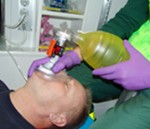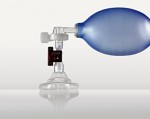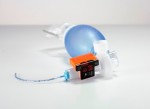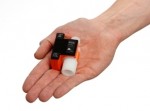Academic Department of Military Surgery & Trauma, Royal Centre for Defence Medicine, Birmingham, UK
07/11/2010
La mesure du CO2 expiré
La mesure du CO2 expiré, élément incontournable de la sécurité en anesthésie, est également recommandé pour le monitorage pré-hospitalier du traumatisé (Consensus SFMU). Parmi les dispositifs utilsables, il faut citer le capnomètre EMMA de la société PHASEIN.
Très simple d'emploi, il apparaît très adapté à nos conditions d'exercice (Voir ici).





Il sera bientôt en doatation, en attendant vous pouvez utiliser un détecteur chimique.

Réchauffer ACTIVEMENT le blessé sédaté
Un article à lire
Body temperature of trauma patients on admission to hospital: a comparison of anaesthetised and non-anaesthetised patients.
Langhelle A et all. Emerg Med J. 2010 Oct 20. [Epub ahead of print]
Abstract
Background Hypothermia at hospital admission has been found to independently predict increased mortality in trauma patients. Objectives To establish if patients anaesthetised in the prehospital phase of care had a higher rate of hypothermia than non-anaesthetised patients on admission to hospital. Methods Retrospective review of admission body temperature in 1292 consecutive prehospital trauma patients attended by a physician-led prehospital trauma service admitted to The Royal London Hospital between 1 July 2005 and 31 December 2008. Results 38% had a temperature recorded on admission. There was a significant difference in body temperature between the anaesthetised group (N=207) and the non-anaesthetised group (N=287): mean (SD) 35.0 (2.1) vs 36.2 (1.0)°C, respectively (p<0.001). No significant seasonal body temperature variation was demonstrated. Conclusion This study confirmed that patients anaesthetised in the prehospital phase of care had a significantly lower admission body temperature. This has led to a change in the author's prehospital practice. Anaesthetised patients are now actively surface heated and have whole body insulation to prevent further heat loss in an attempt to conserve body temperature and improve outcome. This is an example of best in-hospital anaesthetic practice being carried out in the prehospital phase.
En pratique
Le recours à l'association Ready Heat Blanket II, Blizzard Blanket et charlotte thermolite est impératif en cas de sédation préhospitalière (Voir ici). La prudence est de mise en cas d'hypothermie sévère sans frissons (voir ici). On rappelle simplement l'importance de prévenir l'installation de la triade hypoxie/coagulopathie/acidose lors de la prise en charge d'un blessé choqué hémorragique (Voir ici)
06/11/2010
Point sur les pansements hémostatiques
Un article récent fait le tour des pansements hémostatiques.
Review
J. Granville-Chapman, N. Jacobs and M.J. Midwinter
Abstract
Background
Uncontrolled haemorrhage is a leading cause of prehospital death after military and civilian trauma. Exsanguination from extremity wounds causes over half of preven military combat deaths and wounds to the anatomical junctional zones provide a particular challenge for first responders. Commercial products have been developed, which claim to outperform standard gauze bandages in establishing and maintaining non-surgical haemostasis. Since 2004, two advanced haemostatic dressing products, HemCon and QuikClot have been widely deployed in military operations. Newer products have since become available which aim to provide more efficient haemostasis than and thus supersede HemCon and QuikClot.
Aim
To conduct a systematic review of clinical and preclinical evidence to compare the relative efficacy and safety of available haemostatic products, which are of relevance to pre-hospital military and civilian emergency medical providers.
Method
An English language literature search was performed, using PubMed® and Web of Knowledge® Databases, with cross-referencing, focussed product searches and communication with product manufacturers. For studies employing animal models, the injury model was required to produce fatal haemorrhage. Products were categorised by primary mode of action as either factor concentrators, mucoadhesive agents or procoagulant supplementors.
Results
From 60 articles collated, 6 clinical papers and 37 preclinical animal trials were eligible for inclusion in this review. Products have been tested in three different types of haemorrhage model: low pressure, high volume venous bleeding, high pressure arterial bleeding and mixed arterial-venous bleeding. The efficacy of products varies with the model adopted. Criteria for the ‘ideal battlefield haemostatic dressing’ have previously been defined by Pusateri, but no product has yet attained such status. Since 2004, HemCon (a mucoadhesive agent) and QuikClot (a factor concentrator) have been widely deployed by United States and United Kingdom Armed Forces; retrospective clinical data supports their efficacy. However, in some recent animal models of lethal haemorrhage, WoundStat (mucoadhesive), Celox (mucoadhesive) and CombatGauze (procoagulant supplementor) have all outperformed both HemCon and QuikClot products.
Conclusion
HemCon and QuikClot have augmented the haemostatic capabilities of the military first aid responder, but newer products demonstrate potential to be more effective and should be considered as replacements for current in service systems. These products could have utility for civilian pre-hospital care.
Keywords: Dressing; Battlefield; Haemostatic; Combat; Prehospital; WoundStat; QuikClot; HemCon; Celox; Combat Gauze
| Tags : pansement
